
Socken (Swedish: [ˈsʊ̌kːɛn] or [ˈsɔ̌kːɛn])[1] is the name used for a part of a county in Sweden. In Denmark similar areas are known as sogn, in Norway sokn or sogn and in Finland pitäjä (socken). A socken is a country-side area that was formed around a church, typically in the Middle Ages. A socken originally served as a parish. Later it also served as a civil parish or an administrative parish, and became a predecessor to today's municipalities of Sweden, Finland, Norway and Denmark. Today it is a traditional area with frozen borders, in Sweden typically identical to those of the early 20th century country-side parishes. The socken also served as a registration unit for buildings, in Sweden recently replaced by identical districts as registration unit. A socken consists of several villages and industry localities (company towns), and is typically named after the main village and the original church.
Sweden
History
Socken, in old Swedish sokn (compare: Danish and bokmål sogn, nynorsk sokn) is an archaic name for the original country church parishes, kyrksocken. It also describes a secular area, a sockenkommun ("rural area locality") or a taxation area, a jordbokssocken.[2][3] In the Nordic countries a socken was an administrative area consisting of several villages or localities in much the same way as the civil parishes in England, but the concept is not used in reference to towns. A socken had a socken church, it was governed by a socken council and it was the predecessor to modern municipalities[4][5]
In 1862, the kyrksockens ("church socken") and the sockenkommuns ("rural area locality") in Sweden were abolished as administrative areas during municipality reforms. The jordbrukssocken ("taxation area") remained in use until the Fastighetsdatareformen ("Reform for registration of real property") 1976–1995 was complete.[6] No further alterations to the sockens was made after this.
On 1 January 2016, a new administrative division and area for statistics, registration districts or simply districts, was introduced in Sweden. Geographically, the districts correspond with the parishes of the Church of Sweden as of 31 December 1999. About 85% of the old sockens corresponds with the new districts.[7][8][9]
Even though the term socken is no longer used administratively in Sweden, it is still used for cataloging and registering historical archives (Swedish National Heritage Board), botany, dialect research, toponymy and by local historical societies. Socken is a convenient parameter for these purposes since it does not change with time.[10]
Lists of sockens
_landscape._Rapeseed_field_near_Maria_Park_outside_Helsingborg.jpg.webp)
.jpg.webp)

- List of sockens in Sweden on Swedish Wikipedia, sv:Kategori:Socknar i Sverige
See also
References
- ↑ ""Socken" in Svenska Akademiens ordbok". Retrieved 2023-01-03.
- ↑ Svenska akademiens ordlista över svenska språket. Acta Academiae Regiae Gustavi Adolphi, 0065-0897; 57Studier till en svensk ortnamnsatlas, 99-0382294-4; 14 (in Swedish) (12 uppl. ed.). Stockholm: Nordstedts ordbok. 1998. p. 876. ISBN 91-7227-032-2. Retrieved 15 June 2014.
- ↑ Brink, Stefan (1990). Sockenbildning och sockennamn : studier i äldre territoriell indelning i Norden = Parish-formation and parish-names : studies in early territorial division in Scandinavia. Uppsala: Gustav Adolfs akad. ISBN 91-85352-17-9. Retrieved 15 June 2014.
- ↑ "Svenska akademins ordbok". www.saob.se. Svenska Akademin. Retrieved 15 June 2014.
- ↑ Brink, Stefan (1991). Olle Ferm (ed.). "Sockenbildningen i Sverige". Kyrka och Socken I Medeltidens Sverige / Av Roger Andersson. Studier till Det medeltida Sverige, 0347–7495, 5: 113–142. ISBN 91-7192-825-1. Retrieved 15 June 2014.
- ↑ "Förordning (1983:594) om genomförande av fastighetsdatareformen". www.riksdagen.se. Justitiedepartementet F2. Retrieved 15 June 2014.
- ↑ "Distriktsindelning i folkbokföringen". Swedish National Heritage Board. 27 January 2015. Retrieved 23 May 2016.
- ↑ "SFS 2015:493 Förordning om district" (PDF). Swedish Code of Statutes. 17 June 2015. Retrieved 23 May 2016.
- ↑ "Nya folkbokföringsdistrikt" (PDF). Archived from the original on March 4, 2016. Retrieved 2016-05-23.
{{cite web}}: CS1 maint: bot: original URL status unknown (link) In: Lantmäteriet 2014. Lantmäteriet. accessdate=23 May 2016. - ↑ Förteckning över städer och socknar. D. 1, Alfabetisk och efter sockennummer (2., [rev,] uppl. ed.). Stockholm: Riksantikvarieämbetet. 1999. ISBN 91-7209-149-5. Retrieved 15 June 2014.
Further reading
- Almquist, Johan Axel (1917–1923). Den civila lokalförvaltningen i Sverige 1523–1630: med särskild hänsyn till den kamerala indelningen. Meddelanden från svenska Riksarkivet, 99-0506720-5; 6 (in Swedish). Stockholm: Norstedt. Retrieved 16 June 2014.
- Lagerstedt, Torsten (1973). Den civila lokalförvaltningens gränser 1630–1952: kameral redovisning, areell beteckning och gränsförändring. Meddelanden från Kulturgeografiska institutionen vid Stockholms universitet, 0585-3508; B 24 (in Swedish). Stockholm. Retrieved 16 June 2014.
{{cite book}}: CS1 maint: location missing publisher (link)
- Litzen, Veikko (1977). "Om socken". Historisk Tidskrift för Finland (in Swedish). Helsinki: 331–335.
- Svensson, Patric (1999). Peter Aronsson & Lennart Johansson (ed.). "Att skapa ordning och reda: administrativa förändringar på landsbygden omkring 1870–1940". Stationssamhällen (in Swedish). Växjö : Univ., 1999: 146–154. ISBN 9789172661493. Retrieved 16 June 2014.
External links
- Swedish Tax Agency, Parishes in Sweden, historical–current.(in Swedish)
- Swedish National Heritage Board, List of towns and sockens. Archived 2021-11-20 at the Wayback Machine(in Swedish)